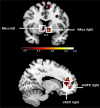Appetitive conditioning with pornographic stimuli elicits stronger activation in reward regions than monetary and gaming-related stimuli
- PMID: 38798103
- PMCID: PMC11128778
- DOI: 10.1002/hbm.26711
Appetitive conditioning with pornographic stimuli elicits stronger activation in reward regions than monetary and gaming-related stimuli
Abstract
Appetitive conditioning plays an important role in the development and maintenance of pornography-use and gaming disorders. It is assumed that primary and secondary reinforcers are involved in these processes. Despite the common use of pornography and gaming in the general population appetitive conditioning processes in this context are still not well studied. This study aims to compare appetitive conditioning processes using primary (pornographic) and secondary (monetary and gaming-related) rewards as unconditioned stimuli (UCS) in the general population. Additionally, it investigates the conditioning processes with gaming-related stimuli as this type of UCS was not used in previous studies. Thirty-one subjects participated in a differential conditioning procedure in which four geometric symbols were paired with either pornographic, monetary, or gaming-related rewards or with nothing to become conditioned stimuli (CS + porn, CS + game, CS + money, and CS-) in an functional magnetic resonance imaging study. We observed elevated arousal and valence ratings as well as skin conductance responses for each CS+ condition compared to the CS-. On the neural level, we found activations during the presentation of the CS + porn in the bilateral nucleus accumbens, right medial orbitofrontal cortex, and the right ventral anterior cingulate cortex compared to the CS-, but no significant activations during CS + money and CS + game compared to the CS-. These results indicate that different processes emerge depending on whether primary and secondary rewards are presented separately or together in the same experimental paradigm. Additionally, monetary and gaming-related stimuli seem to have a lower appetitive value than pornographic rewards.
Keywords: anterior cingulate cortex; appetitive conditioning; fMRI; gaming; mOFC; nucleus accumbens; pornography; reward value.
© 2024 The Author(s). Human Brain Mapping published by Wiley Periodicals LLC.
Conflict of interest statement
The authors declare no conflicts of interest.
Figures





Similar articles
-
Neural correlates of subjective CS/UCS association in appetitive conditioning.Hum Brain Mapp. 2018 Apr;39(4):1637-1646. doi: 10.1002/hbm.23940. Epub 2018 Jan 3. Hum Brain Mapp. 2018. PMID: 29297960 Free PMC article.
-
Appetitive and aversive classical conditioning: Self-reports and physiological responses.Behav Brain Res. 2025 Apr 27;484:115509. doi: 10.1016/j.bbr.2025.115509. Epub 2025 Feb 27. Behav Brain Res. 2025. PMID: 40023255
-
Impact of COMT Val158Met-polymorphism on appetitive conditioning and amygdala/prefrontal effective connectivity.Hum Brain Mapp. 2015 Mar;36(3):1093-101. doi: 10.1002/hbm.22688. Epub 2014 Nov 13. Hum Brain Mapp. 2015. PMID: 25394948 Free PMC article.
-
Involvement of basal ganglia and orbitofrontal cortex in goal-directed behavior.Prog Brain Res. 2000;126:193-215. doi: 10.1016/S0079-6123(00)26015-9. Prog Brain Res. 2000. PMID: 11105648 Review.
-
Appetitive conditioning: neural bases and implications for psychopathology.Neurosci Biobehav Rev. 2007;31(3):426-40. doi: 10.1016/j.neubiorev.2006.11.002. Epub 2007 Jan 8. Neurosci Biobehav Rev. 2007. PMID: 17210179 Free PMC article. Review.
References
MeSH terms
Grants and funding
LinkOut - more resources
Full Text Sources
Medical

